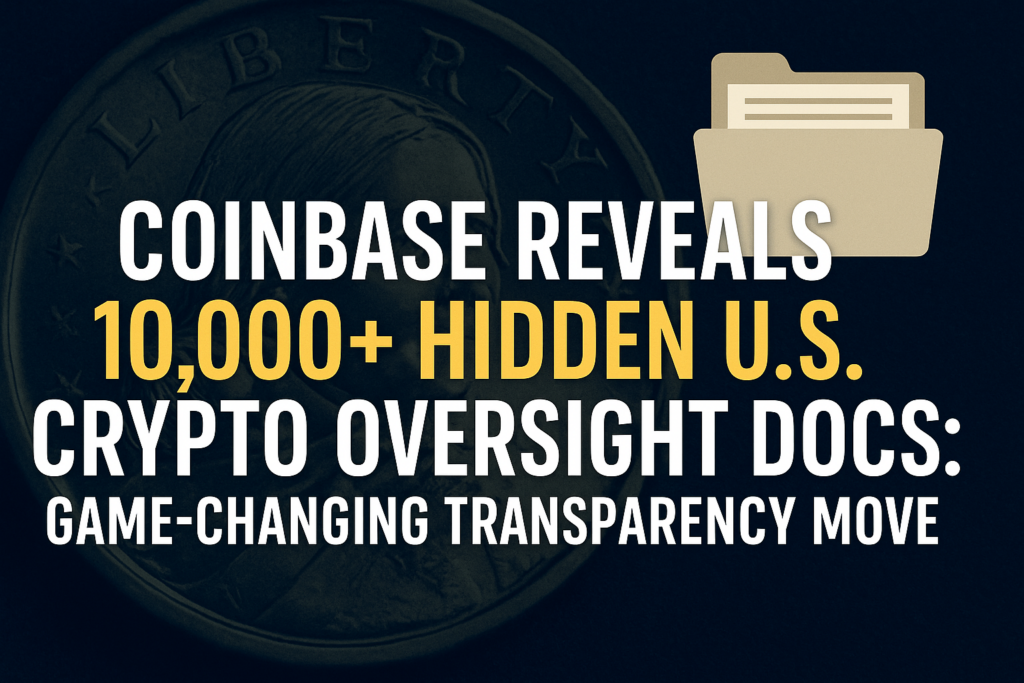
What to Know
- Coinbase released over 10,000 pages of confidential U.S. government crypto oversight documents.
- The files include previously sealed communications between the SEC, CFTC, and Treasury.
- This transparency push aims to highlight inconsistencies in crypto regulation and enforcement.
- The move follows Coinbase’s ongoing legal battle with the SEC.
- It could shape future crypto legislation and investor protection norms.
In a bold move for the crypto industry, Coinbase has lifted the veil on more than 10,000 pages of confidential government documents related to U.S. crypto regulation, exposing what it claims are long-standing issues with how digital assets have been handled by key regulators like the SEC, CFTC, and Treasury.
The document trove, obtained through a Freedom of Information Act (FOIA) request and subsequently published via its Stand with Crypto initiative, could become a defining moment in the ongoing battle between crypto innovation and regulatory clarity.
A Regulatory Maze Now in the Spotlight
Coinbase’s release comes amid its heated legal conflict with the U.S. Securities and Exchange Commission (SEC), which alleges the exchange has been operating as an unregistered securities broker. However, Coinbase has consistently argued that the regulatory environment in the U.S. is fragmented and contradictory, and these newly released documents seem aimed at proving that point.
Among the thousands of pages are:
- Internal emails between SEC and Treasury officials.
- Drafts of crypto-related policy memos.
- Cross-agency disagreements about whether certain tokens should be classified as securities, commodities, or neither.
This unprecedented release offers a rare glimpse into how policy confusion has stalled meaningful crypto regulation in the U.S., often at the expense of investors, builders, and exchanges.
The Impact on the Crypto Industry
Coinbase’s Chief Legal Officer, Paul Grewal, emphasized that this initiative isn’t just about winning a court case—it’s about fixing the system. “Crypto deserves clear rules—not punishment for clarity’s absence,” Grewal wrote in a post tied to the release.
This aggressive transparency push could:
- Shift the narrative around regulatory intent.
- Empower lawmakers with ammunition to draft smarter crypto legislation.
- Pressure regulators to unify their stance instead of contradicting each other in public and private.
Already, pro-crypto legislators like Senator Cynthia Lummis and Representative Patrick McHenry are calling the document release a “game-changer” in terms of providing the legislative context for needed reforms.
Why This Matters Now
With the 2024 elections behind us and 2025 shaping up to be a regulatory inflection point for digital assets, the timing couldn’t be more critical. The U.S. is falling behind as other jurisdictions like Hong Kong, the UAE, and the EU roll out comprehensive frameworks to attract crypto firms.
Moreover, the release could affect the pending Supreme Court review of the Chevron deference doctrine, which currently gives regulatory agencies wide latitude in interpreting laws. A repeal of Chevron could limit how freely the SEC interprets the definition of a “security,” directly impacting its case against Coinbase and others.
Transparency as a Strategic Weapon
While some see this as a legal strategy, others argue it’s a public education campaign. By putting this raw data in the hands of users, developers, and lawmakers, Coinbase is reframing the conversation: “We’re not running from the law—we’re demanding better laws.”
This move also reinforces Coinbase’s identity as a regulation-forward platform—a counter to the narrative that paints crypto as inherently oppositional to oversight.
As Grewal noted, “For crypto to thrive in America, we need rules that are fair, public, and consistent. This release is a step toward that future.”
Looking Ahead
Whether this leads to real change or just fuels more litigation remains to be seen. But one thing is clear: the fight for regulatory clarity in the U.S. has just escalated. With over 10,000 pages now available to the public, the pressure is on for regulators and lawmakers to respond—not just with words, but with action.

